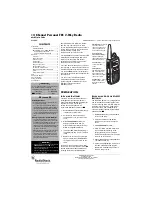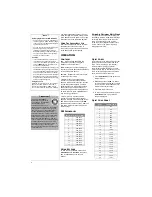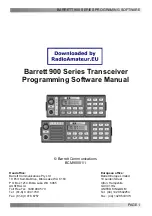
21-1864
AO0108AAA1
07A02
Printed in China
RadioShack Corporation
Fort Worth, Texas 76102
(%%
"
+0(14/#6+10
To be safe:
• Never open your radio’s case.
#
• Never change or replace anything in
your radio except the batteries.
Your radio might cause TV or radio
interference even when it is operating
properly. To determine whether your radio is
causing the interference, turn it off. If the
interference goes away, your radio is
causing it. Try to eliminate the interference
by:
• Moving your radio away from the
receiver.
• Calling your local RadioShack store for
help.
If you cannot eliminate the interference, the
FCC requires that you stop using the radio.
This device complies with Part15 of the FCC
Rules. Operation is subject to the following
two conditions: (1) This device may not
cause harmful interference, and (2) this
device must accept any interference
received, including interference that may
cause undesired operation.
This equipment has been tested and found
to comply with the limits for a Class B digital
device, pursuant to Part 15 of the FCC
Rules. These limits are designed to provide
reasonable protection against harmful
interference in a residential installation. This
equipment generates, uses and can radiate
radio frequency energy and, if not installed
and used in accordance with the
instructions, may cause harmful interference
to radio communications.
However, there is no guarantee that
interference will not occur in a particular
installation. If this equipment does cause
harmful interference to radio or television
reception, which can be determined by
turning the equipment off and on, the user is
encouraged to try to correct the interference
by one or more of the following measures:
Reorient or relocate the receiving antenna.
Increase the separation between the
equipment and receiver.
Connect the equipment into an outlet on a
circuit different from that to which the
receiver is needed.
Consult the dealer or an experienced radio/
TV technician for help.
5#('6;
"
+0(14/#6+10
Your wireless handheld portable transceiver
contains a low power transmitter. When the
Push-To-Talk (PTT) button is pressed, it
sends out radio frequency signals. The
device is authorized to operate at a duty
factor not to exceed fifty percent. In August
1996, the Federal Communications
Commission adopted RF exposure
guidelines with safety levels for handheld
wireless devices.
.
.
.
.
52'%+(+%#6+105
Frequency Range ...............................................................................................462.5625 – 467.7125MHz
Channels .................................................................................................................................................. 14
RF Output Power .......................................................................................................... 400 – 500mW ERP
Power Supply ................................................................................................... 6.0 VDC (4
×
AAA Alkaline)
Battery Life ...................................................................................................... 20 hours (alkaline batteries)
Operation Temperature ..................................................................................... –4 to 122 ºF (–20 to 50 ºC)
Dimension (HWD) ............................................................................ 4
1
/
2
×
2
3
/
8
×
1
1
/
3
in (115 x 61
×
34mm)
Weight..................................................................................................................................... 5.1 oz (148g)
Specifications are typical; individual units might vary. Specifications are subject to change and
improvement without notice.
#
"
+/2146#06
"
#
Do not open your radio to make any internal
adjustments. Your radio is set up to transmit a
regulated signal on one of 14 assigned
frequencies. It is illegal to alter or adjust the
settings inside the radio to exceed those
limitations. Any adjustments to your radio must
be made by a qualified technician using the
proper test equipment.
.
"
%#76+10
"
.
•
To maintain compliance with the FCC’s RF
exposure guidelines, hold the transmitter
and antenna at least 2 inches (5 cm) from
your face and speak in a normal voice, with
the antenna pointed up and away from your
face. If you wear the handset on your body
while using the headset accessory, use only
the supplied belt clip for this product and
when transmitting, take it out of the belt to
ensure the antenna is at least 1 inch
(2.5cm) from your body.
•
Use only the supplied antenna.
Unauthorized antennas, modifications, or
attachments could damage the transmitter
and may violate FCC regulations.






















